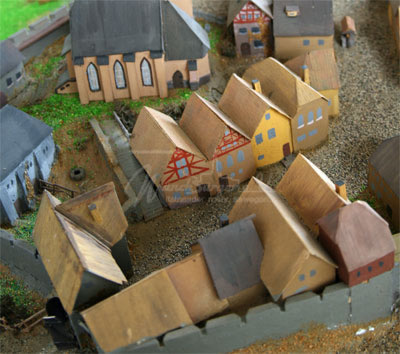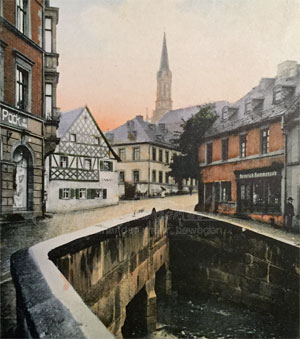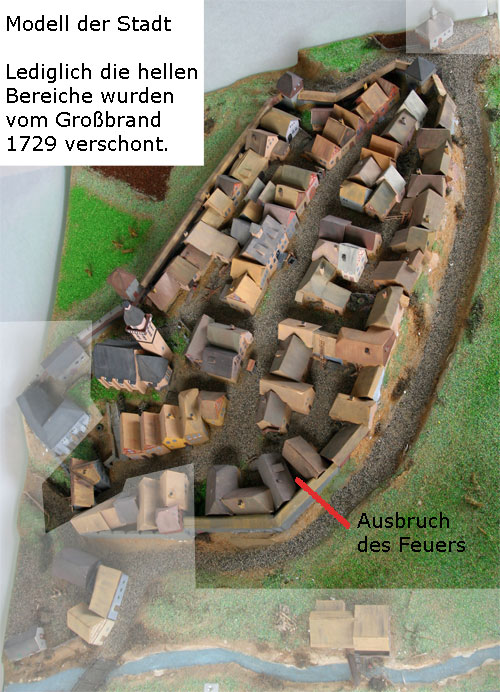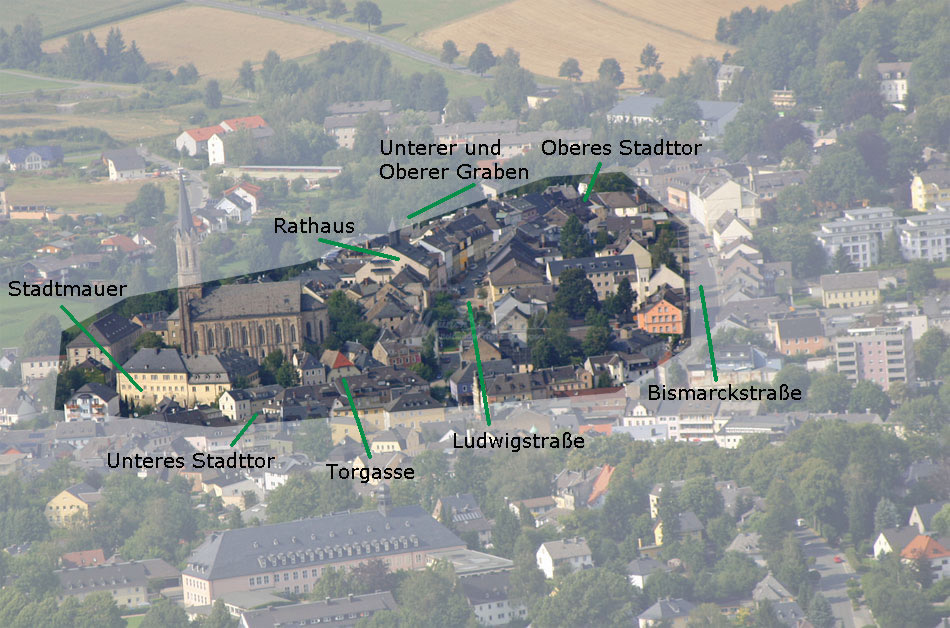
Oldest private houses Torgasse

Unfortunately, buildings were repeatedly destroyed by the many fires in Münchberg, so that there are only a few remains from the previous centuries. The oldest evidence of Münchberg history is found in the cemetery. The cemetery church was built in 1746 and was spared from the great fire, because it was located outside of the city fortifications. Gravestones, which are still older, are set into the northern wall of the church. On the gravestone of Mayor Georg Krinius you can read the date of death as 1626.
 Among the oldest private houses in Münchberg are the buildings on the north side of the Torgasse (gate alley), below the city church. The site plans give information as to which buildings were destroyed after the great fire. The two fire disasters of 1837 and 1845 respectively destroyed large parts of the city, but both times the houses on the Torgasse were spared. They could have been built after the fire of July 16, 1729. This fire broke out in the immediate area of present day Bismarckstraße. The property belonged at that time to Johann Georg Ruckdeschel. Up until this fire, the Frisch, Schöttner and Ottin families were the owners of these three described houses on the Torgasse.
Among the oldest private houses in Münchberg are the buildings on the north side of the Torgasse (gate alley), below the city church. The site plans give information as to which buildings were destroyed after the great fire. The two fire disasters of 1837 and 1845 respectively destroyed large parts of the city, but both times the houses on the Torgasse were spared. They could have been built after the fire of July 16, 1729. This fire broke out in the immediate area of present day Bismarckstraße. The property belonged at that time to Johann Georg Ruckdeschel. Up until this fire, the Frisch, Schöttner and Ottin families were the owners of these three described houses on the Torgasse.
The timber framed house (photo left), about 50 meters south of the Torgasse below the old post house is thought to be the oldest building in the city of Münchberg. It shows in addition one of the few preserved examples of residential buildings from the Baroque period. The splendid timber framed façade and projecting wooden roof indicate a certain prosperity of the one-time inhabitants and show the significance of the city in the early modern era. The historic timber frame house was built around 1700 as a blacksmith shop and belonged in this function to the former stage coach station (later the Hotel Adler). In the 19th century it was converted into a bakery. Since 2015 a study group has worked toward the stabilization of the structure. Further information can be found at www.fachwerkhaisla.de.
 In the city center at that time on Ludwigstraße the houses were built right next to each other and were constructed partly of wood. The roofs were only covered with shingles. So a fire that broke out could quickly spread from one house to another. All of the buildings, which were, located inside the city fortifications between Klosterplatz, Bismarckstraße, Unterem Stadttor (lower city gate) and Oberen Graben (upper ditch) were therefore in greater danger.
In the city center at that time on Ludwigstraße the houses were built right next to each other and were constructed partly of wood. The roofs were only covered with shingles. So a fire that broke out could quickly spread from one house to another. All of the buildings, which were, located inside the city fortifications between Klosterplatz, Bismarckstraße, Unterem Stadttor (lower city gate) and Oberen Graben (upper ditch) were therefore in greater danger.
Seven serious large fires destroyed large parts of the city repeatedly. Already in 1430 there was fire protection during the Hussite wars. In 1534 nearly all of the buildings burned down in a great fire. The next one followed in 1617. On April 1, 1631 the church, the parsonage, the school and other municipal buildings as well as 96 private homes and 17 barns were destroyed by fire. A further fire catastrophe followed on September 26, 1701, in which the church, the superindendur, the two chapels, 82 houses with stables and six barns were burned to ashes within two hours. Also included were the two schoolhouses with expensive libraries. The burning slate from the church tower was scattered over the entire city by strong winds. A bible of the archdeacon Meyer and the table on which it lay, as well as the nearby standing chairs survived the fire, although the church furnishings all around were burned to powder. A large destructive fire followed on July 16, 1729, of which only the area west of the church and the south side of the Torgasse escaped. Otherwise, the church, the town hall, the municipal brewery and more than 50 other houses with neighboring buildings burned down. On August 12, 1837 another bad fire disaster reduced an area in vicinity of the upper city to ashes, in which the flames destroyed over 100 buildings. Finally, in the year 1845 there were two fires, one right after the other, which raged in the Kulmbacher Straße area. In the first night, from July 8 to 9, almost 20 houses were destroyed or damaged. Even worse came two nights later when nearly 50 homes were totally destroyed and almost the same number partly destroyed, including several barns and other wooden buildings. With the demolition work at the scene of the fire, the lower city gate also collapsed.
Along with these bad fires, there are around 20 further fires found in the city archives that repeatedly destroyed buildings. In 1682 the Becher Mill burned down to the foundations. In 1726 the pharmacy burned, in 1823 the Kastner property, in 1834 barns and stable buildings by the post house and in 1841 the Schwarze Adler (Hotel Black Eagle). After the great fire of 1729 the current Margrave supported the reconstruction with money, instead of wood construction (the forest supplied no more, due to the previous fire) and with tax exemptions for ten years. But he wanted the fires counteracted and issued various building regulations. Above all, the gables in the city should no longer be located right at the street, so that between every 5th and 6th house a firewall could be constructed. He had cross lanes laid out as fire breaks and ordered the roofs to be covered with slate rather than wooden shingles. This all happened, but frequently only on the street sides. Mainly, the mayor and the pharmacist Saher covered the backsides of the houses with cheap shingles, a deception that backfired, so that the Margrave threatened the cancellation of the tax exemption and demanded the immediate removal of the shingles and their replacement with red slate.
In the upper city, even today, the former city center around Ludwigstraße is still visible from the air. In the photo below the area of the former city fortification is outlined and important places are labeled accordingly.

Video: Aerial view oldest private houses Torgasse and timber frame house
Copywriters, authors, photographers, rights holders or sources:
Rainer Fritsch, Sandy Schroeder, Adrian Roßner, city archives